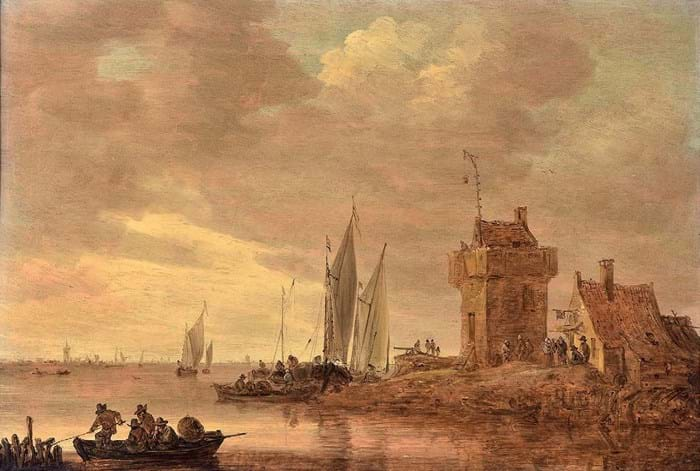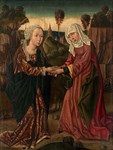“The market remains very selective with the highest prices reserved for the best examples, fresh to the market and competitively price.”
This quote from Jennie Fisher, head of pictures at Dreweatts (25/20/12% buyer’s premium), could currently apply to almost any collecting field but it followed the saleroom’s Old Master, British & European Art auction in Donnington Priory, which chalked up a clutch of decent performances among the 233 lots.
This potent combination of quality, freshness and pricing was behind the success of a 19th century flower still-life by Franz Xaver Petter (1791- 1866), a popular Austrian painter in Vienna during the Biedermeier period.
The undated 3ft 1in x 2ft 2in (94 x 67cm) oil on canvas, uniting various flowers such as lilies, poppies, roses, tulips with fruit and birds, came by descent from the vendor’s mother who is believed to have purchased the work in the c.1920s from Dorotheum in Vienna near where she lived. It was in good condition with only light craquelure throughout and some retouching.
Attractively pitched at £10,000- 15,000 in the December sale, it was taken to £28,000 where it was knocked down to a buyer from the London trade.

An estuary landscape on the Rhine with square tower and tall gallows signal by Jan Josefsz van Goyen – £55,000.
The sale’s leading lot was a fresh-to-market painting by Dutch landscapist Jan van Goyen (1596-1656) last seen on the market nearly a century ago. The view of a watch tower with a gallow signal on the Rhine near Lobith and Schenkenschanz was one Goyen often repeated. The 15 x 22in (38 x 55cm) oil on panel was signed and dated 1652 to the side of a barge in the bottom left of the picture.
Dreweatts described the work as “a fine example of Goyen’s skilful manipulation of tonal variations… Through a limited colour palette Goyen was able to render natural light and subtle atmospheric effects in shades of brown, green and grey.”
Previous owners included the collector Sir Charles Turner and art dealer Paul Cassirer (1871-1926) who promoted the works of Vincent van Gogh and Paul Cézanne. The vendor’s grandfather, who fled Nazi Germany in 1933, had acquired it sometime between 1931-36. Estimated at £60,000-80,000, it got away at £55,000 to the London trade.
Ancestral portraits
Among two considerable private collections was a group of 30 ancestral portraits from Court Lodge, a Georgian manor house in Kent, around half of which sold. Court Lodge was the seat of the Morland family for nine generations between the early 1730s and earlier this year. They married into English nobility and had links to Jane Austen’s family and latterly with the First World War poet Siegfried Sassoon.
Selling to a UK private buyer at £17,000 (£8000-12,000 estimate) was a 19th century copy of a Richard Cosway (1742-1821) portrait of the Courtenay sisters held at Powderham Castle in Devon, seat of the Earls of Devon. The youngest sister, Lady Caroline Courtenay, later married Col Charles Morland and it was probably for the occasion this replica was made.
Affectionately known in the family as The Three Graces, the 6ft x 4ft 4in (1.83 x 1.32m) oil on canvas was painted by Richard Clack (1804-75) and differs from the original with the inclusion of a leaping dog in place of a putti.
The same buyer also secured a copy by an unknown hand of another original portrait at Powderham by Rev Matthew William Peters (1741- 1814) depicting William, Viscount Courtenay (1742-1888), 8th Earl of Devon and his family. It sold below estimate for £9000.
Bulmer collection
Lots 46-58 came from the collector and interior designer Edward Bulmer and had hung at his Grade II-listed William and Mary manor house, Court of Noke in Herefordshire. The group mainly comprised Continental Old Masters depicting religious scenes and Italianate landscapes acquired at Sotheby’s and Christie’s from 1988-90.
A 17th century portrait of a gentleman attributed to the Italian Baroque painter Salvator Rosa (1615-73) attracted the keenest interest. Bearing a later inscription identifying the sitter as the Amalfi fisherman Masaniello, who became leader of the revolt against Spanish rule in Naples in 1647, the 17 x 12in (43.5 x 33cm) oil on canvas sold to a Continental buyer for £13,000, just over double top estimate.
The top-seller of the Bulmer collection and the second-highest price overall was a compact 23 x 17in (60 x 43cm) oil on panel of the Madonna and Child by Bolognese painter Giacomo Raibolini (1486- 1557). He was the son of Francesco Raibolini, one of the most successful artists in Bologna during the late 15th and early 16th centuries. Together with his brother Giulio, he took over the running of the studio when his father died in 1517 and produced numerous altarpieces and religious paintings for the churches and convents of Bologna.
The painting at Dreweatts, which had a visible crack running vertically down the length of the panel, heavy craquelure and areas of loss and flaking, sold on bottom estimate to a UK private collector for £30,000.
Elsewhere, a buyer from the UK trade paid £16,000 for a signed Silvio Poma (1841-1932) view of the village of Feriolo on the shore of Lake Maggiore. The 19th century Italian artist made his name painting land and lakeside views of Lombardy, demand for which has tapered off in the last decade or so on the secondary market.
This was a good example that had been exhibited in 1880 at The National Exhibition of Fine Arts in Turin and came with sensible expectations of £8000-12,000.















